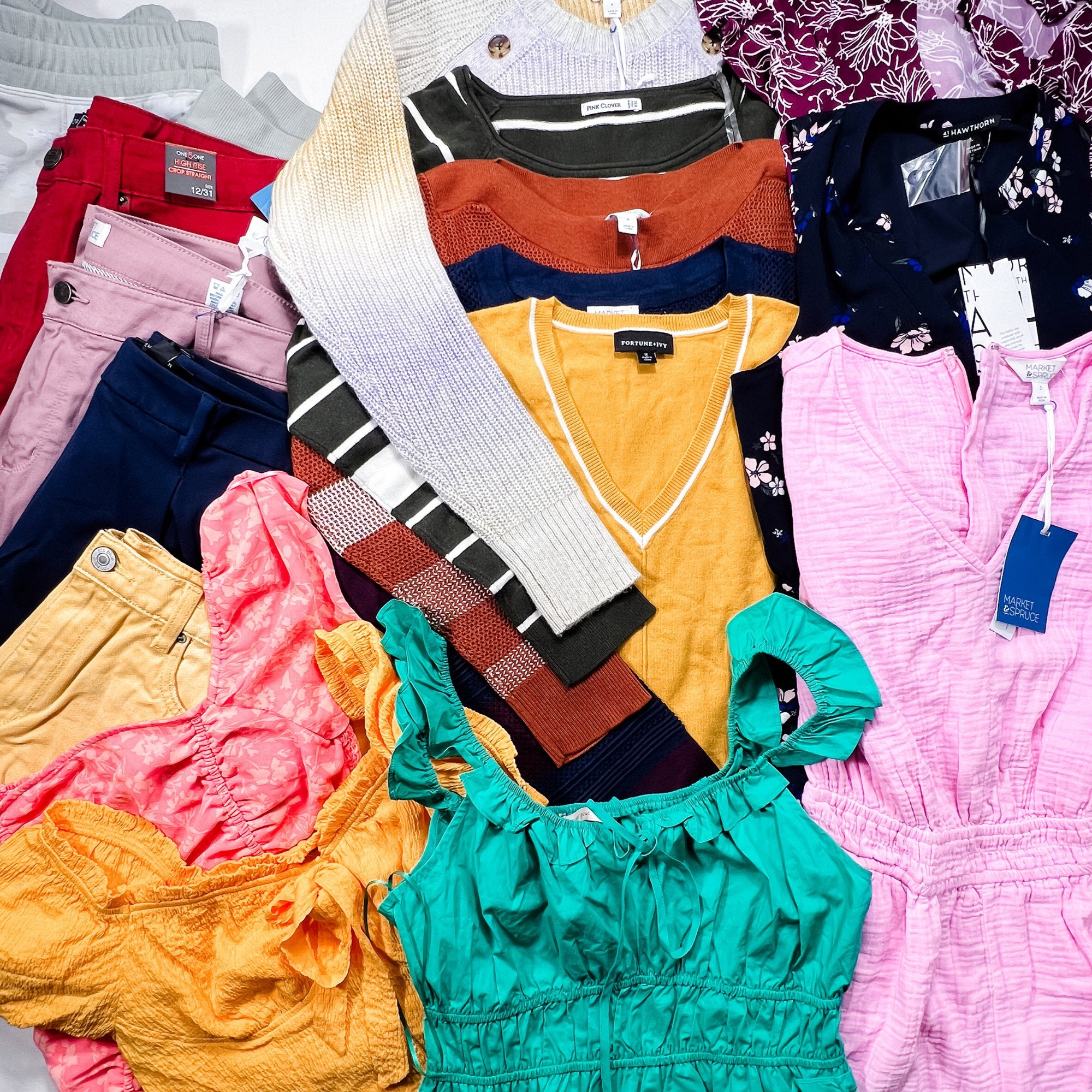Common Fabric Types Used in Branded Clothing and What They Mean
Common Fabric Types Used in Branded Clothing and What They Mean
Blog Article
The Relevance of Lasting Apparel: Just How It Affects the Setting and Your Closet
Lasting clothes is progressively identified for its vital function in lessening the ecological influence of the quick fashion business. By concentrating on eco-friendly products and moral production techniques, it resolves pressing eco-friendly issues. This change not just benefits the planet but additionally influences customer choices, bring about a more thoughtful technique to closet management. Recognizing these dynamics elevates vital concerns concerning fashion's future and individual obligation fit it.
The Ecological Footprint of Fast Fashion

Advantages of Sustainable Products
Lasting products provide considerable advantages, particularly through green textile selections that reduce environmental damage. These materials additionally show toughness and durability, reducing the demand for regular replacements. Consequently, they add to an extra sustainable fashion business and advertise responsible consumer behavior.
Eco-Friendly Material Selections
While the garment industry has actually long been associated with rapid trends and ecological harm, the rise of environmentally friendly fabric selections presents a transformative chance. Lasting products such as natural cotton, hemp, and Tencel have actually gained appeal due to their reduced ecological impact. These materials are typically generated without unsafe pesticides and need less water, decreasing their carbon footprint - Branded Clothing. Furthermore, numerous environmentally friendly textiles are biodegradable, adding to a circular economy by decreasing waste. Selecting sustainable materials not only sustains eco accountable methods however also promotes much healthier environments. As customers become extra familiar with their buying power, the demand for environmentally friendly textiles encourages brand names to innovate and adopt more sustainable manufacturing methods, eventually benefiting the earth and future generations
Longevity and Long Life Advantages
Numerous customers are progressively recognizing the durability and longevity advantages of lasting materials in their apparel choices. Unlike traditional materials, sustainable materials such as organic cotton, hemp, and recycled polyester are crafted to withstand deterioration, resulting in garments that last much longer. This minimized regularity of replacement not just conserves consumers money gradually yet likewise diminishes waste created by quick fashion. In addition, sustainable apparel frequently utilizes environmentally friendly manufacturing techniques that boost textile stamina, adding to a decrease in the total carbon impact. By purchasing resilient clothes, customers can grow a more lasting wardrobe while delighting in high-grade items that keep their aesthetic and capability gradually. As a result, resilience and longevity stand as vital benefits of picking lasting materials.
Reducing Waste Via Lasting Practices
Minimizing waste in the fashion business can be attained through innovative techniques such as upcycling and repurposing products. In addition, adopting minimal wardrobe methods encourages consumers to focus on top quality over quantity, eventually decreasing garments intake. Together, these methods contribute greatly to a more sustainable clothes version.
Upcycling and Repurposing Products
Upcycling and repurposing products have become cutting-edge techniques in the style sector, transforming thrown out textiles right into important brand-new products. This strategy not only reduces waste yet additionally encourages creative thinking and individuality in clothes layout. By taking old garments and materials, designers can produce unique pieces that mirror personal style while lowering the demand for new resources. In addition, upcycling frequently needs much less power and water contrasted to standard production processes, substantially reducing the ecological impact of fashion. As customers come to be more knowledgeable about sustainability, the appeal of upcycled clothing continues to rise, promoting a circular economy. Eventually, these practices add to a more lasting future, where style focuses on ecological wellness over quick production and intake.

Minimalist Wardrobe Methods
As individuals increasingly look for to minimize their environmental effect, taking on minimal wardrobe techniques has gained traction as an efficient strategy to lasting fashion. These methods highlight high quality over quantity, motivating customers to curate a smaller sized collection of functional, resilient garments. By concentrating on classic items that can be mixed and matched, people can minimize the frequency of purchases and ultimately decrease waste.Additionally, minimalism promotes conscious usage, advising customers to assess the moral and ecological ramifications of their options. This method not just fosters an extra sustainable way of life but additionally simplifies daily decision-making relating to outfit. As individuals accept minimal concepts, they contribute to a style society that values sustainability and liable consumerism, eventually bring about a much more eco-conscious culture.
The Role of Ethical Labor in Lasting Style
While many consumers are increasingly familiar with the environmental consequences of their clothes options, the value of moral labor methods in sustainable style can not be overlooked. Moral labor encompasses fair wages, secure working problems, and regard for workers' legal rights, forming the foundation of responsible style manufacturing. Brand names that prioritize moral labor not only uplift communities yet also established a requirement for accountability in the industry.Moreover, the integration of moral methods cultivates openness, making it possible for consumers to make informed choices concerning their acquisitions. This practice contrasts sharply with fast fashion's unscrupulous labor models, which frequently focus on profit over people. By sustaining firms dedicated to moral labor, consumers add to a system that values human dignity together with ecological sustainability. Subsequently, moral labor is not just an add-on; it is crucial to the more comprehensive goal of sustainable style, ensuring that the mission for eco-friendliness does not come at the expense of civils rights.
The Effect of Sustainable Clothes on Carbon Emissions
Sustainable clothes has the potential to greatly lower carbon exhausts related to the apparel industry. Conventional garment manufacturing contributes notably to greenhouse gas discharges, mainly as a result of energy-intensive production processes and making use of non-renewable sources. In comparison, sustainable style concentrates on environment-friendly products, such as organic cotton or recycled fibers, which commonly need less power to produce.Moreover, lasting brands often tend to take on much more reliable production practices, minimizing waste and reducing general exhausts. By focusing on toughness and timeless design, lasting clothes motivates consumers to buy much less regularly, further decreasing the carbon impact related to overconsumption.Additionally, several sustainable brands are devoted to openness in their supply chains, making it possible for consumers to make educated selections that align with their values. Eventually, moving towards lasting apparel can lead to a considerable reduction in carbon exhausts, adding to a healthier earth and a much review more sustainable future for the fashion market.
Sustaining Local Economies With Lasting Selections
The shift towards sustainable clothing not just addresses ecological problems but likewise substantially benefits local economic situations. By selecting lasting fashion, consumers typically support local craftsmens and small companies, improving community resilience. These business generally run on a smaller sized scale, prioritizing craftsmanship and moral techniques over mass production.Investing in locally made sustainable garments cultivates task creation and promotes financial growth within communities. As consumers come to be much more mindful of the ecological influence of their acquisitions, they significantly look for out items that mirror their worths. This demand encourages regional producers to embrace lasting techniques, adding to a circular economy.Moreover, sustaining regional services minimizes transportation emissions, aligning with eco-conscious customer habits. The interconnectedness of sustainable clothing and neighborhood economic climates highlights the necessary function that specific options play in advertising both ecological and financial wellness. By promoting these neighborhood links, areas can flourish while also functioning towards a more sustainable future.
Transforming Your Closet: Tips for a Lasting Closet
As people look for to minimize their environmental influence, transforming a wardrobe into a lasting wardrobe comes to be an essential step. One efficient approach is to examine existing clothes, maintaining only things that are worn consistently and that line up with sustainability goals. Prioritizing high quality over quantity is essential; buying durable pieces from green brand names can substantially decrease waste.Additionally, including second-hand products can breathe new life right into a closet while reducing ecological damage. Organizing garments swaps with buddies or contributing extra items can even more promote sustainability.When buying, individuals need to look for materials that are natural, recycled, or biodegradable, and stay clear of rapid style stores - Branded Clothing. Lastly, practicing mindful intake by thoughtfully considering each purchase can contribute to a more sustainable way of living. By applying these suggestions, one can create a wardrobe that mirrors individual style while supporting ecological stewardship
Often Asked Concerns
Exactly How Can I Determine Sustainable Apparel Brands?
To determine lasting garments brands, one ought to investigate products utilized, look for accreditations like Fair Trade, and check out the brand's transparency regarding their manufacturing procedures, labor methods, and environmental impact, guaranteeing honest and green practices are prioritized.
What Are the Expenses Related To Lasting Style?
The expenses linked with sustainable style can vary considerably. news Greater manufacturing costs, honest sourcing, and eco-friendly materials typically cause enhanced market prices, which may discourage some consumers while attracting eco aware buyers.
Can Sustainable Clothing Be Fashionable and elegant?
Lasting clothes can indeed be elegant and stylish. Designers increasingly focus on innovative products and honest production approaches, showing that fashion and sustainability can exist together. Consumers now have varied choices that mix appearances with ecological consciousness.
Exactly How Does Washing Clothing Affect Their Sustainability?
Washing clothing greatly influences sustainability by consuming water and energy, adding to pollution, and triggering microplastic launch. Frequent washing can break down fabrics, reducing their lifespan and boosting the demand for substitutes, inevitably intensifying ecological problems.
What Is the Lifespan of Sustainable Garments Contrasted to Fast Fashion?
The life-span of sustainable apparel commonly exceeds that of quick fashion products, usually enduring a number of years because of top quality products and workmanship. In contrast, rapid fashion garments may degrade quickly, requiring more regular replacements. Sustainable clothes is significantly acknowledged for its essential role in minimizing the environmental influence of the rapid style sector. While several customers are progressively mindful of the ecological effects of their clothes choices, the importance of honest labor methods in lasting fashion can not be ignored. Branded Clothing. Sustainable clothes has the potential to substantially reduce carbon discharges linked with the style market. In contrast, sustainable fashion focuses on environment-friendly products, such as organic cotton or recycled fibers, which commonly need less power to produce.Moreover, lasting brands have a tendency to adopt extra reliable manufacturing methods, lessening waste and lowering total emissions. By prioritizing longevity and classic style, lasting clothing encourages consumers to buy much less often, further click this link reducing the carbon impact linked with overconsumption.Additionally, numerous lasting brand names are dedicated to openness in their supply chains, enabling consumers to make informed selections that line up with their worths
Report this page